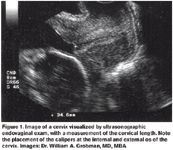MFM Consult: Understanding management of low-risk woman with short cervix
An ultrasound for a normal pregnancy reveals a shortened cervix. It's important to understand how to manage this scenario.
Q: A 29-year-old patient (gravida 1, para 0) with no significant gynecologic history and an uncomplicated antepartum course presents for an ultrasonographic survey at 22 weeks' gestation. The singleton pregnancy appears anatomically normal, but transabdominal imaging reveals a cervix that appears shortened. An endovaginal ultrasound examination is then performed and reveals a cervix that measures 19 mm. How should this patient be managed during pregnancy?

Because preterm birth is relatively infrequent among women at low risk, such as nulliparous women with singleton gestation, most women who are incidentally discovered to have a short cervix will not actually deliver preterm. The chance of delivering before 35 weeks after the finding of a short cervical length in a low-risk population has been reported to be 14% (ie, the positive predictive value).3
Progesterone has been considered as a potential therapy to reduce the risk of preterm delivery in high-risk women, including those with a short cervical length. Only one randomized trial focusing on this issue has been completed, but this trial included a heterogeneous group of low and high-risk women and only enrolled those with a cervical length of 15 mm or less.5 In this group of women, progesterone did reduce the probability of preterm birth at less than 34 weeks (relative risk, 0.56; 95% confidence interval, 0.36–0.86). Although a randomized, controlled trial of progesterone prophylaxis in nulliparous women with a cervical length less than 30 mm using endovaginal ultrasonography is currently in progress by the NICHD MFMU Network, results will not be available in the near future.
Finally, Berghella and colleagues combined data from randomized trials of indomethacin therapy for women with a short cervical length but were unable to demonstrate less frequent preterm birth before 35 weeks' gestation with this intervention.6
Because no therapy has been shown to reduce the probability of preterm birth for a woman such as the one under consideration, the obstetric provider can review signs and symptoms of preterm labor and apprise her of her increased risk of preterm birth. Although some clinicians suggest limitation of activity or bed rest for women at increased risk for preterm birth, it is unclear whether this approach prevents prematurity or improves newborn outcomes.7
